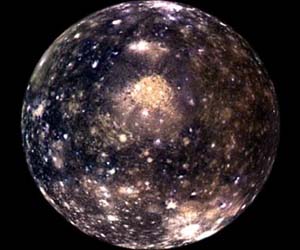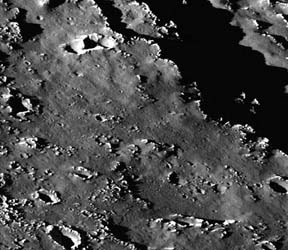|
|
Callisto Moon Facts
Callisto Facts
- Callisto is the second largest moon orbiting Jupiter and the third largest moon in the solar system.
- It has a diameter of 2,985 miles (4,800 km), which is only 1% smaller than the planet Mercury.
- Callisto is the 8th moon in distance from Jupiter and takes 17 days to make one complete orbit of the
planet. - It orbits Jupiter at an average
distance of 1,168,000 miles
(1,880,000 km). - Callisto orbits beyond Jupiter's main radiation belt.
- Due to its orbit being further away from Jupiter it is not under the same tidal influences as Io, Europa or Ganymede.
- It has the lowest density of any of the "Galilean Moons".
- It could have a similar subsurface ocean to those found on Europa and Ganymede.
- Callisto is the most cratered object in the solar system and has the oldest landscape.
- The moon was discovered in January 1610 by the Italian astronomer Galileo Galilei.
 Image taken by Galileo in 1996 showing Callisto's highly cratered surface, the lighter areas are ice.
Image taken by Galileo in 1996 showing Callisto's highly cratered surface, the lighter areas are ice.
Surface, Atmosphere & Temperature
Callisto's Surface
Callisto may be rather bland in appearance compared to the other "Galilean Moons" but still has a mysterious looking landscape. Its icy surface is around 4 billion years old with no significant geological changes in that time.
It is heavily cratered with rather strange icy peaks.
Callisto's Atmosphere
Callisto has an extremely thin atmosphere although unlike Europa and Ganymede it is composed primarily of carbon dioxide. It is now known that all four of the Galilean Moons have some form of atmosphere.
Callisto's Temperature
The highest daytime temperature on Callisto is around-108C (-162 F). At night temperatures can reach an even
more chilly -193C (-315 F).
Callisto Origin of Name and Life

Close up image of Callisto's surface taken by Galileo.
Origin of Name
Callisto is named after a nymph from Greek mythology who became a lover of Zeus. See Europa for a more detailed explanation.
Life on Callisto
Microbial life may exist in the thin ocean underneath Callisto's surface. Although the conditions would be far less
favorable than on Europa or Ganymede.
Images & Video
Callisto enhanced color view


Callisto Rotation
Surface of Callisto


Future and Past Missions to Callisto
Europa Jupiter System Mission
 Launch: 2020
Launch: 2020Agency: NASA/ESA
Although EJSM's mission is to primarily study Europa and Ganymede they will also study Callisto hopefully sending back new data on the moon.
Update: Due to budget cuts Nasa will now no longer be able to participate fully in this mission. The initial idea of sending twin spacecrafts has been abandoned, instead the ESA will send a sole probe (see above).
Update: Due to budget cuts Nasa will now no longer be able to participate fully in this mission. The initial idea of sending twin spacecrafts has been abandoned, instead the ESA will send a sole probe (see above).
|
|




